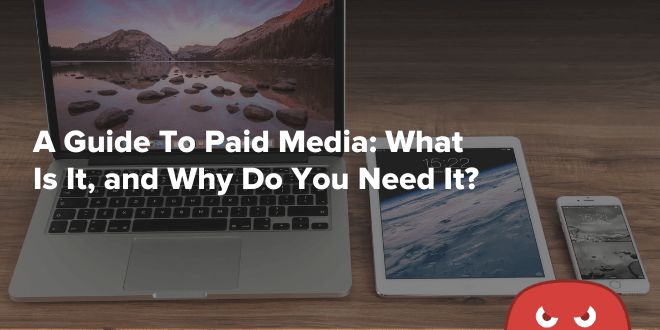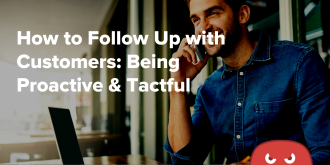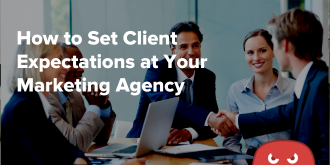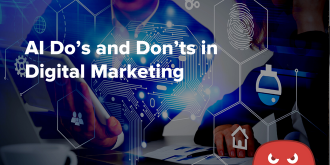Quick Links
Digital ads have been dominating traditional ads in recent years. That dominance continued in 2021, with a survey showing that most chief marketing officers (CMOs) spend 72.2% of their marketing budget on pure digital channels.
Today, paid media or advertising is an avenue for companies and creators to gain customer attention on social and search channels that host millions of posts — not just newspaper or TV ads. It helps them get their foot in the door and generate attention, leads, and sales in an increasingly crowded marketplace.
To help you build a better digital marketing strategy, this post explores paid media, its benefits, how it differs from owned and earned media, and trends to consider in 2022.
What is paid media?
Unlike content marketing, where a company tries to attract an audience organically, paid media involves ads and sponsorships — paying someone else to promote their content, product, or services. The goal is to build brand awareness and generate more leads and sales.
While every marketing strategy relies on valuable content, it won’t make a difference if no one views or reads your posts. In an effort to gain recognition and reach new audiences, businesses use paid advertising to promote their posts.
Search ads, shopping ads, social media ads, paid promotion for content, sponsored content, etc., are all forms of paid media. While paid media requires significant investment to get started, it can provide a great ROI and generate qualified leads when implemented correctly.
Paid media has become increasingly essential for companies to help them stand out and attract user attention in a very crowded and competitive digital marketplace filled with millions of companies.
Ideally, every marketing strategy includes paid, earned, and owned media. Each has its own role in the marketing process.
Differences between paid, earned, and owned media
In marketing, there are three types of media — earned, owned, and paid. You must understand how each works to create an effective strategy.
Owned media refers to any channel that the organization fully owns. These include a website, blog, and social media accounts like a YouTube channel. They act as an extension of your brand, and you have complete control over it.
Owned media is used to build a brand presence over time, not drive sales in the short term.
Earned media leads users to your owned media using primarily organic methods. You have to earn recognition and engagement. Any blog or press mentions — for example, as a result of publishing original research — are forms of earned media.
A great side-effect of earned media it that through links, it helps your owned media place higher in the SERPs and drive more traffic and conversions. This is why a good SEO and content strategy are crucial.
Paid media can help boost both earned and owned media. You can place ads that lead users to owned media, like your website, or you can promote your earned media, like an infographic, through sponsored social media posts.
The benefits of paid media
Let’s break down some of the benefits organizations will receive through a paid media strategy.
Increased brand reach
Organic social media reach is on the decline for brands, with each post only reaching 5.2% of your audience on average. Social media and content marketing strategies must include paid media to increase a brand’s reach.
With targeted advertising, you’re guaranteed to reach more people. Increased brand reach means your content gets more views and will lead more users down the sales funnel.
More attention on social media channels
Millions of companies have social media profiles and post their own content. Instagram, by itself, hosts more than 200 million business accounts.
That’s a lot of competition. Paid media helps you get your voice heard and organic posts viewed and shared.
Digital ads are affordable
Depending on the type of ads you’re running and the end goal, digital ads are an affordable option. No ten-thousand minimum contracts or big upfront payments required.
You can reach your target audience and pay only for each ad impression or click.
You can drive traffic, leads, and sales with cost-per-click (CPC) ads. Or, you can focus on brand awareness and push a video ad on a cost per 1,000 impressions (CPM) model.
Flexible pricing means you get to pick your goals and pay for only what you use.
Improved targeting
Ad agencies and software have evolved to provide you with hyper-targeted options. Ads can be created for your specific buyer personas and desired geographic location.
So, if you’re targeting men aged between 40 and 55 in Cleveland, Ohio, your ads reach this specific group of people. You can also choose when, where, and how many times to show them the ad.
Through market analysis and customer research, you can create ads and deploy them to directly reach your target persona, rather than a generic ad that you hope the audience is interested in.
You can cast your advertising net, to say, as wide as you want, or you can limit it to specific demographics, locations, job titles, etc.
Definite metrics
Paid digital channels offer definite metrics that you can use to track the success or failure of your marketing strategy.
Unlike many other forms of digital marketing or traditional paid media, marketers can monitor paid media efficiency through concrete data. You can see all new impressions, clicks, and conversions in real-time.
This helps you track progress and change any elements that aren’t performing as expected.
Ad platforms provide both current and historical data so you have a deeper understanding of your audience and can optimize campaigns for increased conversions.
Better testing
Defined metrics and hyper-targetable campaigns can help you test out different elements within your ad strategy with ease. This experimentation will help you create better campaigns that help generate more leads.
You can send multiple versions of an ad on a platform, easily see what works based on audience reactions and metrics, and then refine your messaging to suit audience needs.
Retargeting campaigns
When a user has shown interest in your company, product, and service, via a social media interaction or ad click-through, you can run retargeting campaigns.
Retargeted ads are very specific ads that are relevant to a particular audience to garner continuous engagement.
If a user clicks on a previous ad and browsed through your website and products, you can send them ads that are focused on these products to stay in their mind and, hopefully, boost your ROI.
Regular targeted ads also help keep current customers interested in your product or business.
Targeted Google audience reached in seconds, not months
A new business will likely struggle to get atop the search engine result pages (SERPs), but with search ads, you can access targeted search traffic from day one.
You can place ads for specific keywords, so when users search for that term, your ad will appear on the results page, leading users directly to your site.
Paid ads can complement your organic SEO efforts, which usually take time to come to fruition.
Types of digital paid media
There are multiple types of paid media, but let’s focus on the more accessible and practical digital channels.
1. Search engine ads
Search engine ads are advertisements that appear on top of the SERPs. They can target a high-level generic keyword or a long-tail and very specific keyword.
Google marks these results as ads with a small tag, but many users don’t even realize that they are ads, not organic results, as long as you do it right. If you search for “Tires,” for example, here’s what you get:
Since most users rarely look past the first page of Google, they’re more likely to view and click your ads.
You can also buy shopping ads, where your products are listed on top of search results. Here’s an example for the term “diamond ring”:
Shopping ads appear prominently, along with price tags and ratings, leading customers directly to your product. They’re a great way to increase sales.
If you want to learn how to use search ads to drive more traffic, leads, and sales, The HOTH PPC team can help.
2. Paid social media
Every major social media platform has multiple advertising options, including carousel ads, promoted posts, and even influencer promotions. Facebook, Instagram, LinkedIn, YouTube, and Twitter are the most often used channels for paid promotions.
These platforms offer business accounts that let you promote posts and publish ads to target specific users. They’re excellent for social media marketing.
For example, Facebook Ads enables users to create and launch ad campaigns in minutes. The platform has a simple process: choose your goal, audience, budget, and format, and voila! Your ads are ready to go.
Business accounts on these platforms also include analytics tools to measure ad performance.
Apart from paid social media advertising, you can also pay influencers to promote your content.
Influencer marketing on platforms like Instagram and TikTok is a great way to introduce your product, content, or service to a specific audience. Sponsored posts usually cost a predetermined fee or percentage of sales, varying based on the influencers’ audience size and type.
3. Banner or display ads
Banner ads have been around for ages and are probably the most recognizable form of paid media. These ads appear on top of web pages and throughout and on the sides of the main content. They lead users to the advertiser’s landing page.
Here’s an example:
The easiest way to measure performance for banner ads is the click-through rate, which is the number of users that clicked on the ad vs. the number of impressions (or views).
4. Native ads
Native advertisements are similar to banner ads, except they match the general look of the website they are on.
The most common examples of native ads are Sponsored, Suggested, or Recommended Stories. They typically look like this:
Many news and entertainment sites have these ads alongside their original content. Viewers might show more interest in these ads since they don’t blatantly look like ads. Instead, they seem like generic suggestions from a site they’re already on.
Sponsored and promoted content on social media are also examples of native ads.
5. Out-of-home and digital out-of-home ads
Out-of-home (OOH) ads include billboards, posters, signs inside stores, public transportation stations, benches, etc. They’re made to appeal to the general public. A McDonald’s poster on the subway wall is an OOH ad.
Digital out-of-home (DOOH) advertising is the digital version of traditional OOH ads. These include digital billboards, display ads, screens at kiosks, and digital signs. Organizations often opt for digital signage since they’re more flexible, can include videos or multiple images, and engage viewers more.
The best example of a DOOH campaign is Apple’s “Shot on iPhone” digital billboards that everyone is bound to have seen by now. These billboards showcase multiple stunning images to highlight why anyone that wants good pictures should get an iPhone.
Billing models for paid media
There are two standard payment models for digital paid media today:
- Cost per click (CPC)
- Cost per mile (CPM)
As the name suggests, CPC is focused on clicks on your ad that lead to your landing page. It is also known as a pay-per-click (PPC) campaign.
Every time a user clicks through to your landing page, the ad platform gets paid. You can bid on how much you’re willing to pay for each click and set a maximum bid amount.
CPM is all about impressions. In this model, you pay per 1,000 ad views, regardless of if users click through or not.
A CPC model is ideal for performance-based ad campaigns where the goal is to drive conversions, boost traffic, and complement existing organic campaigns. However, if your paid media campaigns have goals like increasing brand awareness and visibility, a CPM model works best.
5 paid media trends for 2022 and beyond
Now that you understand what paid media is, let’s explore some of the more recent trends to help you create a strategy that works in 2022 and beyond.
1. Paid video ads
Videos have become an essential part of most marketing strategies since they cater to users’ dwindling attention spans and can often relay information more clearly than text.
In a 2021 report, 84% of respondents said they were convinced to buy a product or service by watching a brand’s video.
Video marketing has been proven effective, so marketing teams are likely to invest more in paid video ads. You can create organic video content and then get paid promotion on YouTube videos and social media platforms like Instagram, Twitter, and Facebook.
2. Paid media automation
Automation has spread through every aspect of marketing, and paid media is no exception. With the boom in SaaS tools, the paid media industry has seen the growth of many third-party platforms offering their ad solutions.
Many of these platforms use AI to speed up the campaign optimization process, saving ad managers a ton of time.
AI and automation became more prominent in 2021, and that trend will only grow in 2022. As a result, you can speed through your paid media optimization process at scale.
Ad automation involves tools that can automatically adjust bids, optimize ads for device type, add negative keywords, and do other day-to-day tasks. This enables marketing teams to better implement and scale a refined strategy to better target potential customers.
3. Enhanced audience targeting
Advanced paid media tools and strategies don’t just target users based on location, keywords, or demographics. They combine multiple factors to deliver hyper-targeted ads that attract more qualified leads.
For example, a small-town REALTORⓇ can create general ads for their services, and, with advanced targeting, they can also target users who want to leave big cities in favor of “country living.”
Gone are the days of surface-level targeting, where your ads are shown to thousands or millions in the hopes of reaching a few interested prospects. With current paid media tools, you can create ads that are highly relevant to the people they’re shown to.
So, even if only a hundred people view your ad, there’s a high chance that many of them actually care about your product or service.
4. Paid Instagram Stories and TikToks
Both Instagram Stories and TikToks have become a part of daily life for millions of consumers, and businesses are capitalizing.
Over 4 million businesses were using Instagram Stories ads every month in 2020. This figure is expected to have grown in the last two years, with millions of brands capitalizing on the captivating format to bring awareness to their products or service.
TikTok has a similar story. The platform, focused solely on short videos, hit 1 billion active monthly users in 2021 and is on track to become consumers, marketers, and advertisers’ favorite channel.
Last year, a report even claimed that TikTok had surpassed YouTube for average monthly watch time in the US and UK on Android phones, with users averaging 24+ hours per month on TikTok.
Both Instagram Stories and TikToks provide brands the opportunity to connect with their audience on a personal level, both through organic content and influencer marketing. Paid Stories ads and TikToks will grow going forward.
5. Focus on the Flywheel
In marketing, the flywheel model aims to build customer loyalty and encourage recurring purchases. This model has become more popular over the last decade, with many companies choosing the flywheel model over the traditional marketing funnel.
The funnel encourages one-time customers, but the flywheel aims to use personalized content and paid marketing strategies, including paid ads, to retarget users and keep them focused on your brand.
Since the flywheel model is focused on repeat purchases, it creates brand advocates, aka people who will vouch for your products and services, to their friends, family, and peers. This, in turn, leads to a customer base that grows organically over time.
Conclusion
Paid media is a valuable asset that complements your organic growth efforts. It helps build brand awareness and increases brand reach beyond just your own website and social media.
A good paid media strategy takes into account all the latest trends, both in the paid media industry and your own, to create a personalized and targeted campaign.
If you feel lost in the world of paid media, our PPC experts can help you drive leads and sales without breaking the bank. Schedule a call today to start getting results from digital advertising.

















